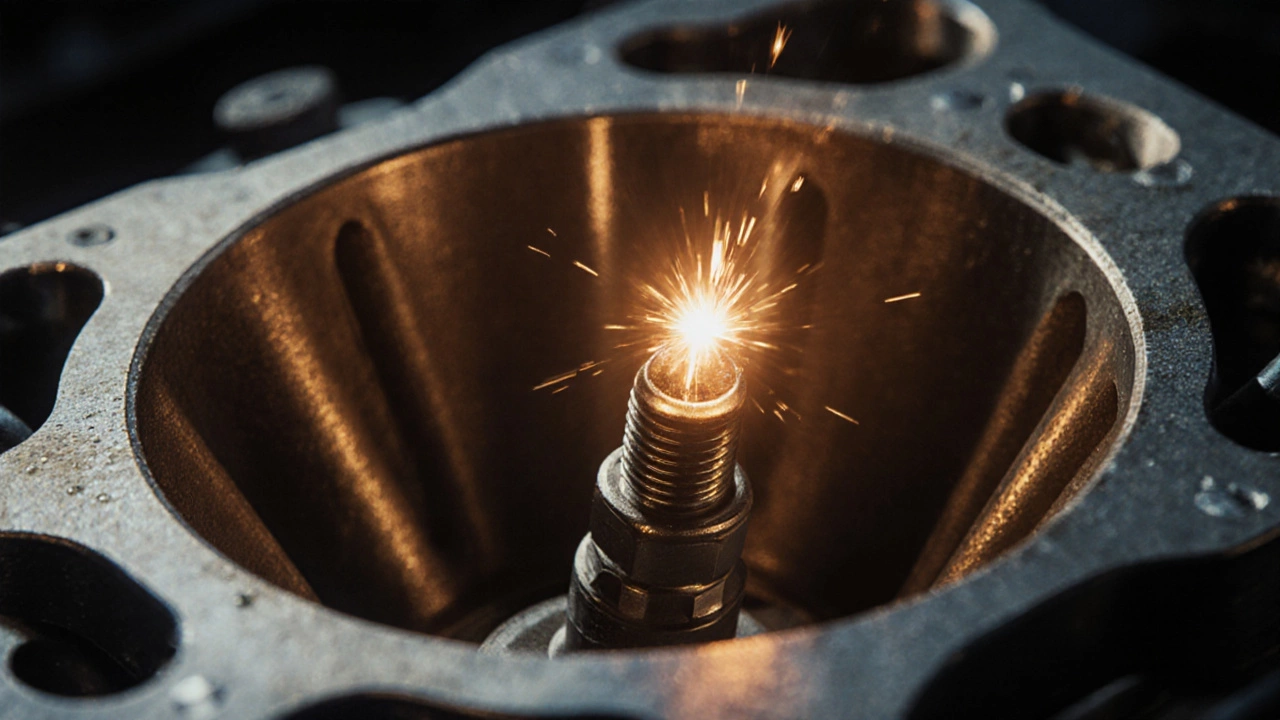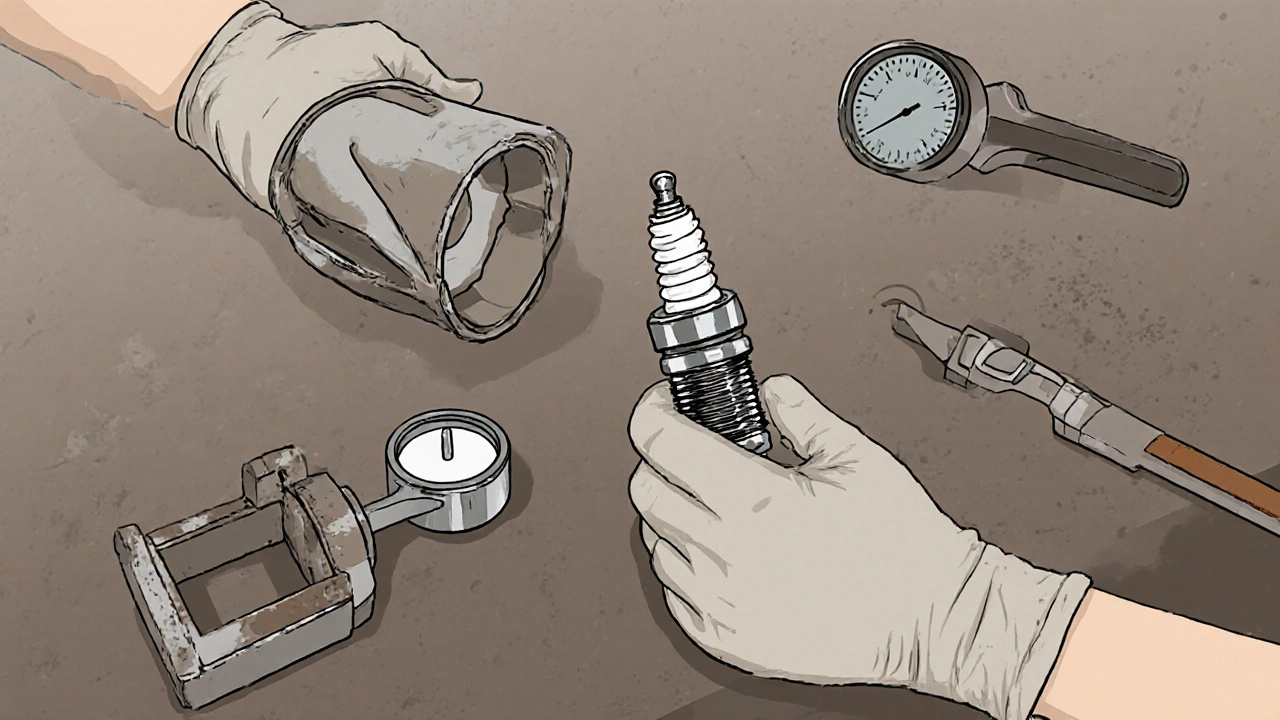Do New Spark Plugs Boost Car Performance?
 Oct, 8 2025
Oct, 8 2025
Spark Plug Performance Calculator
Estimated Performance Gains
When your car feels sluggish or you notice a dip in fuel mileage, the first thing many drivers think of is the engine oil or a clogged air filter. Yet one of the smallest components-the spark plug a metallic device that delivers an electric spark to ignite the air‑fuel mixture inside the combustion chamber-can have a surprisingly big impact on how smoothly the engine runs.
How a Spark Plug Powers the Engine
The ignition system’s job is simple: create a spark at just the right moment. The ignition system a collection of components including the coil, distributor (or coil‑on‑plugs), and spark plugs that generate and deliver high‑voltage electricity to the engine charges a tiny gap inside each plug. When the voltage jumps across that gap, it ignites the compressed air‑fuel mixture, causing a controlled explosion that pushes the piston down and turns the crankshaft.
This tiny burst of energy happens thousands of times per minute. If the spark is weak, late, or mistimed, the combustion becomes incomplete, which means lost power, higher fuel consumption, and more emissions.
Why New Spark Plugs Can Make a Difference
Over time, spark plugs wear down in three main ways:
- Electrode erosion: The central and ground electrodes melt slightly with each spark, reducing the gap and weakening the spark.
- Fouling: Oil, carbon, or fuel residues coat the electrodes, insulating them.
- Heat‑range shift: The plug’s ability to dissipate heat changes, leading to pre‑ignition or misfire.
When any of these issues arise, the engine’s fuel mixture the precise blend of gasoline and air that must be ignited for efficient combustion may not burn completely. The result is a noticeable loss in engine torque the rotational force produced by the engine that determines acceleration, a drop in spark plugs efficiency, and higher exhaust emissions.

Choosing the Right Plug: Material, Heat Range, and Gap
The market offers three popular materials:
- Copper - excellent conductivity, low cost, but wears quickly (typically 20,000‑30,000km).
- Platinum - a thin coating on the center electrode that extends life to about 60,000km.
- Iridium - a tiny, super‑hard tip that can last 100,000km or more while maintaining a tight spark.
Beyond material, the heat range a rating that indicates how quickly a spark plug can transfer heat from the tip to the engine head is crucial. A ‘hot’ plug stays hotter longer, ideal for low‑rev, turbocharged engines, while a ‘cold’ plug dissipates heat faster, better for high‑rev or heavily tuned setups.
Finally, the spark plug gap the distance, usually measured in millimetres, between the center and ground electrodes that the spark must bridge must match the manufacturer’s specification. A gap that’s too small weakens the spark; too large can cause the coil to over‑work and misfire.
| Type | Material | Typical Lifespan | Heat Range Options | Best For |
|---|---|---|---|---|
| Copper | Copper core with nickel alloy | 20‑30k km | Limited (mostly standard) | Older gasoline engines, budget builds |
| Platinum | Platinum‑coated center electrode | 50‑60k km | Standard & some high‑performance | Daily drivers, mild performance upgrades |
| Iridium | Iridium tip on both electrodes | 80‑100k km+ | Wide range (hot to cold) | Turbocharged, high‑rev, long‑interval service |
Installing New Spark Plugs the Right Way
Even a premium plug can under‑perform if installed poorly. Follow these steps:
- Allow the engine to cool. Hot metal can expand, causing cross‑threading.
- Remove the old plug with a spark plug socket a six‑point socket designed to grip the plug hex and prevent damage and a suitable extension.
- Inspect the cylinder head for carbon deposits; clean if necessary.
- Check the new plug’s gap with a feeler gauge. Adjust gently with a gap tool; never force the electrodes.
- Apply a thin layer of anti‑seize (or use plugs that come pre‑coated) to the threads.
- Hand‑tighten the plug, then use a torque wrench to the manufacturer’s spec (usually 13‑18Nm for most passenger cars).
- Reconnect the ignition coil or plug wire, ensuring a snug fit.
Skipping any of these steps can lead to a stuck plug, a misfire, or premature wear.
Measurable Benefits: Power, Economy, and Emissions
Real‑world tests consistently show modest but tangible gains after replacing old plugs with fresh, correctly specified ones. Typical improvements include:
- Horsepower: 1‑3% increase, noticeable during acceleration.
- Fuel consumption: 0.5‑2% better mileage, because the engine burns the mixture more completely.
- Emissions: Lower unburned hydrocarbons and carbon monoxide, which helps pass stricter Euro7 standards.
- Engine smoothness: Fewer “rough idle” sensations and a steady RPM rise.
While the numbers aren’t dramatic, the cost of a set of quality plugs is modest (often under £30), making the return on investment attractive for most drivers.

Cost‑Benefit Analysis: When Is It Worth Upgrading?
If you’re on a tight budget, stick with the OEM‑recommended copper or platinum plugs and replace them at the manufacturer‑specified interval. However, consider upgrading in these scenarios:
- You’ve added a turbocharger or high‑flow intake-an high‑performance ignition system upgraded coils and control modules that demand a stronger, more consistent spark will benefit from iridium’s tighter gap and hotter spark.
- You drive long distances between services-iridium’s 100kkm lifespan cuts down on future labor costs.
- You’re chasing every possible efficiency gain to meet fleet‑wide fuel‑economy targets.
In most everyday situations, replacing worn plugs with the correct spec will restore original performance, which in itself is a win.
Common Misconceptions About Spark Plugs
1. “All plugs are the same.” - Material, heat range, and construction vary widely, affecting durability and spark quality.
2. “A larger gap always means more power.” - Too big a gap can cause misfires and damage the coil; manufacturers design the gap for optimal combustion.
3. “You can skip the torque step.” - Over‑tightening risks thread damage; under‑tightening can let the plug loosen under heat cycles.
Understanding these nuances helps you avoid cheap fixes that end up costing more in the long run.
Frequently Asked Questions
How often should I replace my spark plugs?
Most manufacturers recommend replacement every 30,000-45,000km for copper plugs, 60,000km for platinum, and up to 100,000km for iridium. Always check the owner’s manual for the exact interval.
Can I mix different types of spark plugs on the same engine?
It’s not advisable. Mixing materials or heat ranges can lead to uneven combustion, causing one cylinder to run hotter or leaner than the others, which may trigger a misfire.
Do high‑performance plugs improve fuel economy?
Yes, but the gain is modest-typically 0.5% to 2% better mileage-because the engine burns fuel more completely when the spark is strong and correctly timed.
What symptoms indicate a fouled spark plug?
Rough idle, engine stumbling during acceleration, reduced power, higher fuel consumption, and a check‑engine light pointing to a misfire code are classic signs.
Is it worth paying extra for iridium plugs on a standard commuter car?
If you drive long distances and prefer longer service intervals, iridium can be cost‑effective. For short‑trip commuters with regular maintenance, a quality platinum plug usually offers the best balance of price and performance.